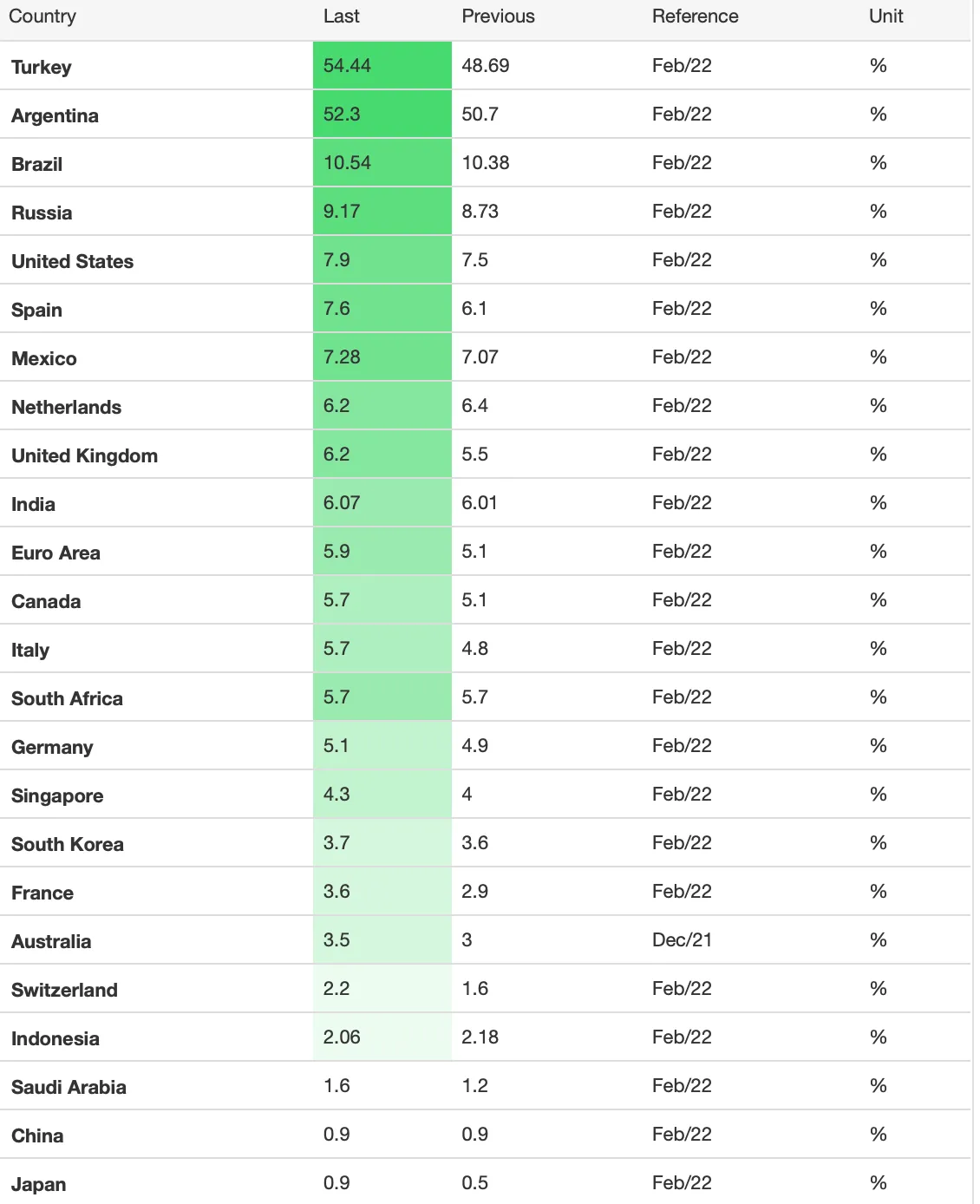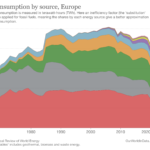Johannes Eber – The Pixel economist
Inflation is back. After many years of low inflation rates, prices have recently risen in much of the world.
The chart below shows the inflation rate of the G20 countries compared to the same month a year ago (I took the chart from here).

In this post, I would like to answer the following question: Is this rising inflation a problem, and if yes, what can be done about it?
For economists, rising prices are – in the first place – not a problem but a signal. Several years ago, Robert Shiller, one of 2013’s Nobel Prize winners in economics, carried out a survey about attitudes towards inflation.
One of his questions was: “Do you agree that preventing high inflation is an important national priority, as important as preventing drug abuse or preventing deterioration in the quality of our schools?”. For the US population as a whole, 52 per cent answered “Fully agree”, but only 18 per cent of professional economists.
The difference is because of the perspective. Ordinary people fear that as prices rise, they will not be able to buy as much as before. But even with inflation, this is not always the case. Over most periods, the inflation level in prices is roughly similar to the inflation level in wages, and so, on average, over time, people’s economic status is not greatly changed by inflation.
This is different in many countries at the moment. Inflation has picked up sharply. And that’s where the problems begin, also, for economists. Because unexpectedly changing inflation rates lead to unintended redistributions.
Two examples:
- Redistribution between debtor and creditor: Consider someone who borrows 10,000 US-Dollars to buy a car at a fixed interest rate of 6 per cent. If inflation is 3 per cent when the loan is made, then the loan must be repaid at a real interest rate of 3 per cent. But if inflation rises to 6 per cent, then the real interest rate on the loan is zero. In this case, the borrower’s benefit from inflation is the lender’s loss. The lesson is that when interest rates are fixed, rises in the inflation rate tend to penalise suppliers of financial capital, while demanders of financial capital end up better off.
- Inflation can also cause unintended redistributions for wage earners since wages typically creep up with inflation. Increases in wages lag behind inflation for a year or two since wage adjustments are often somewhat sticky and occur only once a year or every two years.
The higher the inflation rates, the greater the problems. In situations such as those currently observed in Turkey, prices are increasingly losing their most important function: determining the value of goods.
Even more evident than it is currently the case in Turkey, it was in Israel in 1985. The annual rate was 500 per cent, so the stores stopped showing prices directly on items. It was just too laborious. They would have had to put new labels on the items or shelves every few days to reflect inflation. So the shoppers took things from a shelf and went up to the checkout register to find out the price for that day. Obviously, this situation makes comparing prices and shopping for the best deal difficult.
So not rising, but surprisingly rising inflation rates are a problem. The question is, should something be done about it, and if so, what. The answer is: it depends. It depends on the cause of the increase in inflation.

When Zimbabwe introduced a 100,000,000,000 bill Zimbabwean dollars in 2008 (see picture above), it was almost worthless. At that time, prices doubled every day. There was no desire to hold on to currency since it lost value by the minute. The people there spent a great deal of time getting rid of any cash they acquired by purchasing whatever food or other commodities they could find. At one point, a loaf of bread cost 550 million Zimbabwean dollars. Teachers were paid in the trillions a month; however, this was equivalent to only one US dollar a day. It took 621,984,228 Zimbabwean dollars to purchase one US dollar at its height. Eventually, the country abandoned its currency and allowed foreign currencies to be used for purchases.
How could this happen? So-called hyperinflations have two causes: an increase in the money supply and a so-called demand-pull inflation. The second follows the first. Instead of tightening the money supply to stop inflation, the government or central bank might continue to print more money. With too much currency sloshing around, prices skyrocket. Once consumers realize what is happening, they expect continued inflation. They buy more now to avoid paying a higher price later. That excessive demand aggravates inflation. It’s even worse if consumers stockpile goods and create shortages.
There is no escape from such a vicious circle. The currency must be abolished, and a new, credible monetary policy established. In such a case, a foreign currency is used, at least for a transitional period.
Hyperinflation is a rare exception, “normal” inflation is more common.
There are six reasons for inflation (I took this list from here):
1) Demand-pull inflation: This happens when the demand for certain goods and services is greater than the ability of providers of goods and services to meet those demands. When this demand outpaces supply, there’s upward pressure on prices — causing inflation.
2) Cost-push inflation: Here, inflation occurs when the cost of wages and materials goes up.
3) Increased money supply: If the money supply – provided by the central bank – increases faster than the production rate, this could result in inflation. Then, too many dollars – or whatever the currency is – chasing too few products.
4) Devaluation: Devaluation means when the value of one’s currency falls against foreign currencies. This makes a country’s exports less expensive, encouraging foreign nations to buy more of the devalued goods. It also makes foreign products for the devaluing country more expensive, which encourages citizens to buy domestic products over imports.
5) Rising wages: If wages rise faster than the productivity of companies, businesses will either have to pass the cost on or live with lower margins.
6) Certain policies and regulations: There are many ways government policies can influence inflation. Two examples are increasing government spending (leads to increasing demand) and tax subsidies for certain products (increases demand, too).
Since we know the different reasons for inflation, and since we know that for fighting inflation successfully, you have to know the causes, the question is: What is the cause of the current trend of rising inflation globally and what can be done about it?
Inflation has been driven by supply chain disruptions and pent-up consumer demand for goods following the reopening of the economy after the pandemic in 2021. In addition, the war in Ukraine has increased concerns about disrupted supply chains, and the possible end of resources from Russia has caused the world market prices for those recourses to rise even further.
Therefore, two sides are driving the currently rising prices simultaneously: increasing demand and faltering supply.
Will these developments continue? Maybe not. At least the supply chain problems that arose due to the pandemic will gradually resolve. And in the medium term, alternatives will be found for the lack of oil and natural gas from Russia.
However, inflation may not decline. Because there is a risk of an inflationary spiral.
In wage negotiations, attempts will be made to compensate for the real wage losses that have arisen as a result of increased inflation. As a result, the prices of goods and services will continue to rise, which will result in further wage increases.
The central bank, whose task it is to keep inflation rates low, may then intervene. It will raise the interest rates at which it lends money, which means less money will be borrowed from the central bank, which means that the money supply in circulation will become tighter.
In the end, the economy slumps because investments decline (because investment needs money), demand falls, and prices drop.
Inflation is then successfully combated. But this may come at a high price.
Author Profile

-
Founder of the "Good morning Europe blog" and Pixel economist
Guest author for European Liberals for Reform
Johannes' articles are originally written for the “Good morning Europe” blog (www.goodmorningeurope.org) and the Pixel economist (https://thepixeleconomist.substack.com).
We were given permission to publish his articles on the European Liberals for Reform blog.
Latest entries
Post Disclaimer
The opinions expressed by the author of this post do not necessarily represent the opinions and policies of ELfR.




